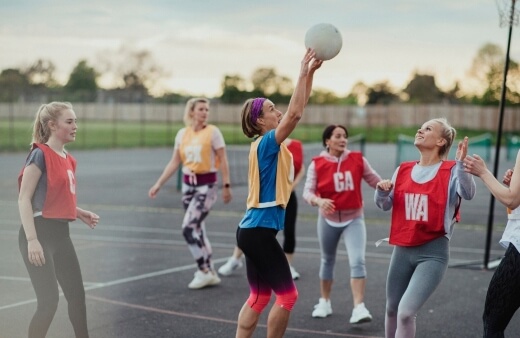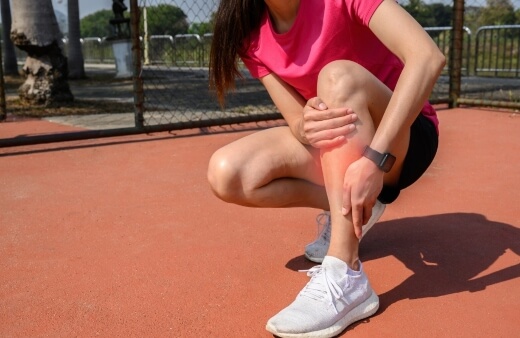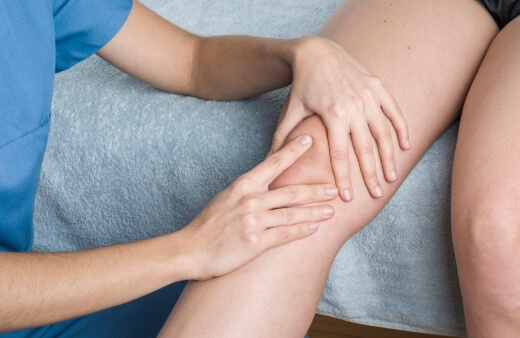Netball is played by people of all ages and is one of Australia’s most popular team sports. It is played for fun on weekends, in schools, at clubs, and professionally. The sport is very physical, and netball injuries are extremely common.

Most Common Netball Injuries
Netball puts a large amount of stress on the body. To play, you need to be able to handle the fast pace and physical demands. People that play netball can experience a wide range of injuries. Most injuries players face occur to the finger, wrist and lower leg.
1. Netball Ankle Sprains
An ankle sprain often happens then the ankle is twisted. This stretches the ligaments and tears them. Common signs of a sprain can include pain, bruising and swelling.
Types of Ankle Sprains
There are three types of ankle sprains: lateral sprains, medial sprains, and syndesmotic sprains. These sprains can be caused by jumping, changing direction, and rapid acceleration
How Serious are Ankle Sprains?
The severity of ankle sprains can vary from mild to severe. They are classified in 3 categories:
-
1st degree
With a 1st degree ankle sprain, you may experience mild pain and stiffness. There will be little to no swelling.
-
2nd degree
With a 2nd degree ankle sprain, you may experience severe pain stiffness, swelling and joint instability
- 3rd degree
With a 3rd degree ankle sprain, you will have swelling and severe pain. You may also experience loss of function.
Treatment of an Ankle Sprain
A sprained ankle can take anywhere from 2 to 90 days to heal. Treatment usually involves rest, ice, compressions and elevation. In 2nd degree cases, you may need to immobilise your ankle with a splint.
In severe 3rd degree sprains, you may need a leg cast or walking boot. In rare instances, surgery may be required.
How to Prevent a Sprained Ankle
Ankle strengthening exercises should be performed on a regular basis to strengthen weak ankles and prevent ankle injuries. Other ways to prevent a sprained ankle are:
- Wear shoes that support your ankle
- Play netball on level ground
- Do not play if there are any hazards in the way
- Warm up before exercising
- Perform slow stretches when done exercising
- Wear netball ankle guards
2. Shin Splints
Shin splints can happen when the bone tissue and leg muscle are overworked and experience stress.

Symptoms of Shin Splints
Shin splints can cause mild to severe pain in the lower leg, tenderness to the touch, and mild swelling. The pain can be continuous, or you may only have pain when walking or running.
Treatment of Shin Splints
Shin splints can take anywhere from 3 to 6 months to heal. Treatment usually involves rest, ice, anti-inflammatory painkillers, arch supports, and physiotherapy.
How to Prevent Shin Splints
You can help prevent shin splints by wearing the proper shoes, gradually build your fitness level, keep a healthy weight, warm up before exercising, participate in low impact exercises and strength training.
3. Achilles Tendonitis
Achilles Tendonitis occurs due to overuse of the Achilles tendon. The Achilles tendon is the tissue that connects the heel bone to the calf muscles.
Symptoms of Achilles Tendonitis
Achilles Tendonitis causes pain in the back of the heel. The pain can make it difficult to walk.
Treatment of Achilles Tendonitis
Achilles Tendonitis can take several months to heal. Treatment usually involves anti-inflammatory medication, orthotic devices and physical therapy. In severe cases, surgery may be necessary.
How to Prevent Achilles Tendonitis
There are ways to prevent and treat Achilles Tendonitis. These include physical therapy and wearing the proper shoes.
4. Patellar Tendonitis
Patellar Tendonitis is also known as Jumper’s Knee. Patellar Tendonitis is the inflammation of the patellar tendon. The patellar tendon passes through the knee and attaches the quadriceps to the shinbone.

Symptoms of Patellar Tendinitis
Pain in the knee is the main symptom of Patellar Tendinitis. The pain may only be felt when playing netball, or it may be continuous.
Treatment of Patellar Tendinitis
If properly treated, Patellar Tendinitis can heal within 6 weeks. If surgery is required, it can take as long as 6 months. Treatment usually involves ice, anti-inflammatory medication, a knee brace and physiotherapy. If the tendon is torn, it may require surgery.
How to Prevent Patellar Tendinitis
There are a few things you can do to help prevent Patellar Tendinitis. These include warming up and cooling down, knee strapping for netball, and performing strength and conditioning exercises.
Netball Injuries Prevention
Physiotherapy is a great way to help prevent netball injuries. At Sydney Sports and Exercise Physiology, our Physiologists will create a personalised exercise program that will strengthen your muscles and improve your balance.
Along with physiotherapy to prevent injuries in netball, you can:
- Warm up and cool down
- Wear the proper shoes
- Wear protective equipment
- Tape your ankles or wear netball ankle guards
- Stay at a healthy weight
- Do not play on uneven ground
- Always remove hazards out of the play area
- Learn and perform the best stretches for netball players
Prevent Netball Injuries with Physiotherapy
At SSEP, our accredited Exercise Physiologists will create a personalised exercise program based on your assessment. Physiotherapy can help you heal from an existing netball injury and prevent future injuries.
Call us today to learn more about how exercise and strength training can prevent netball injuries.
